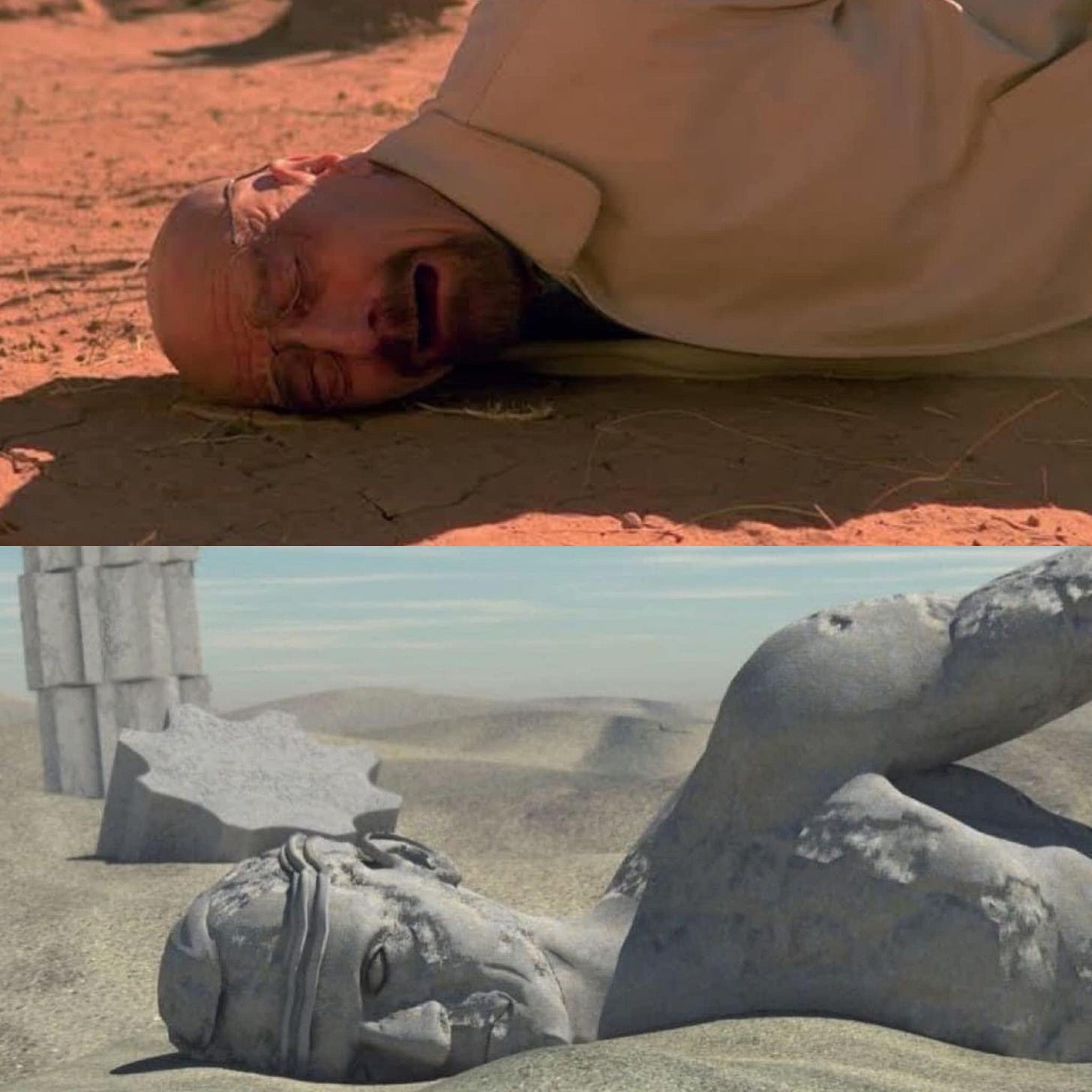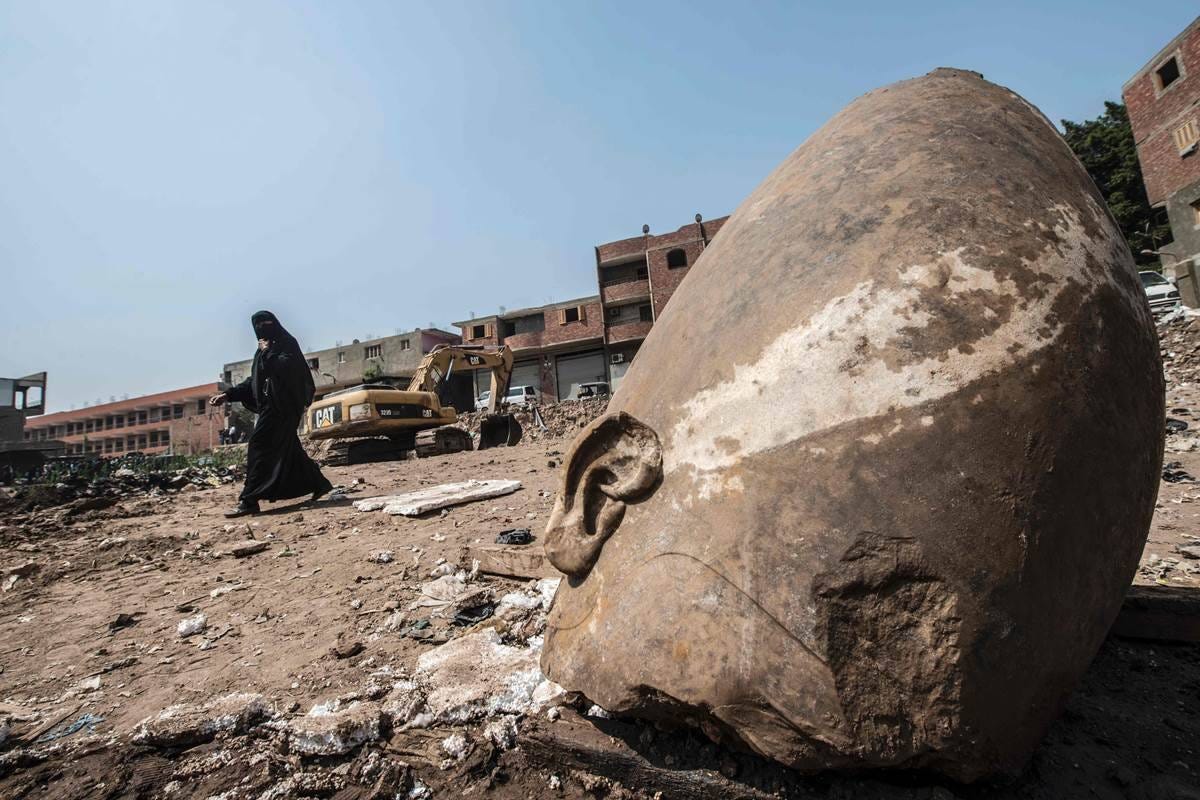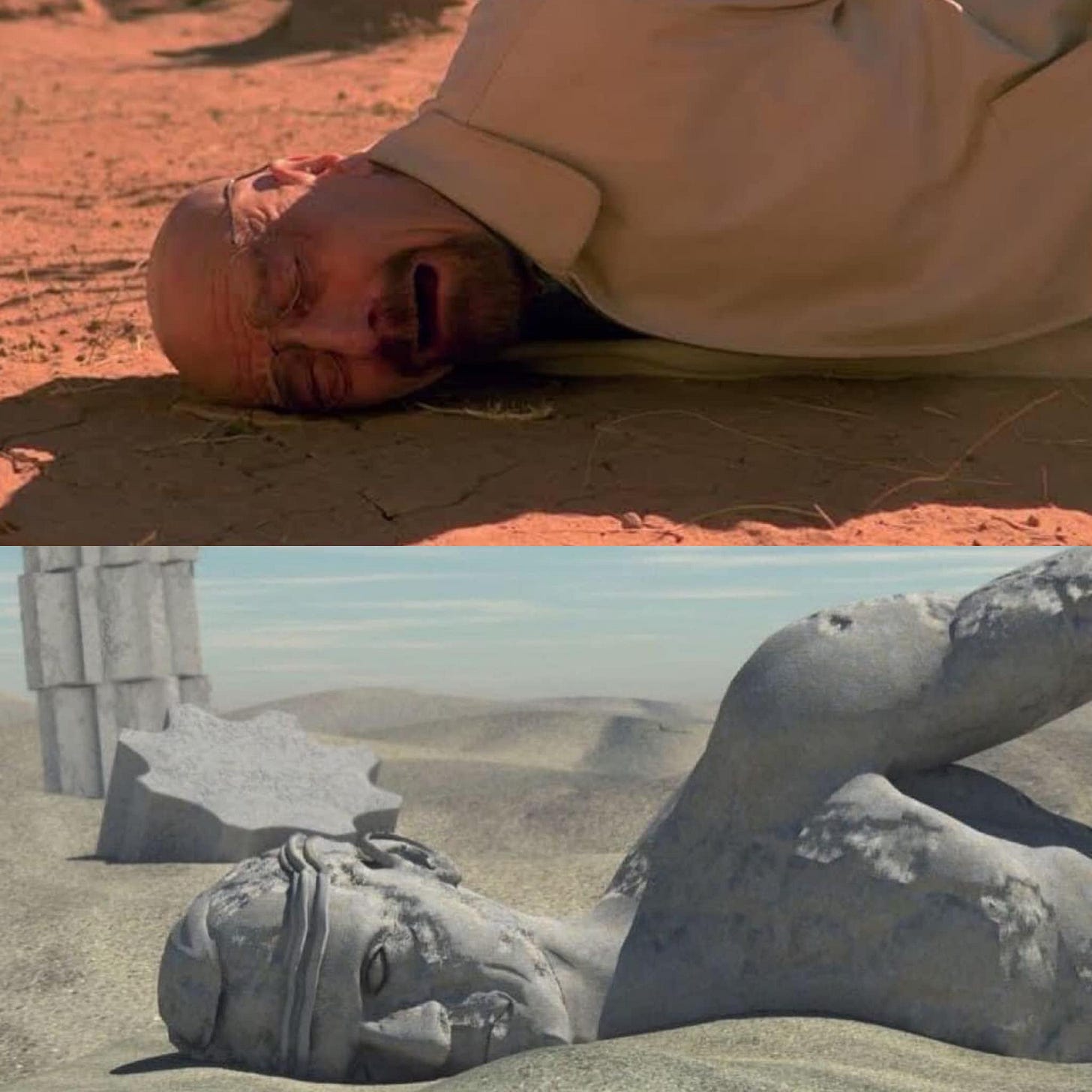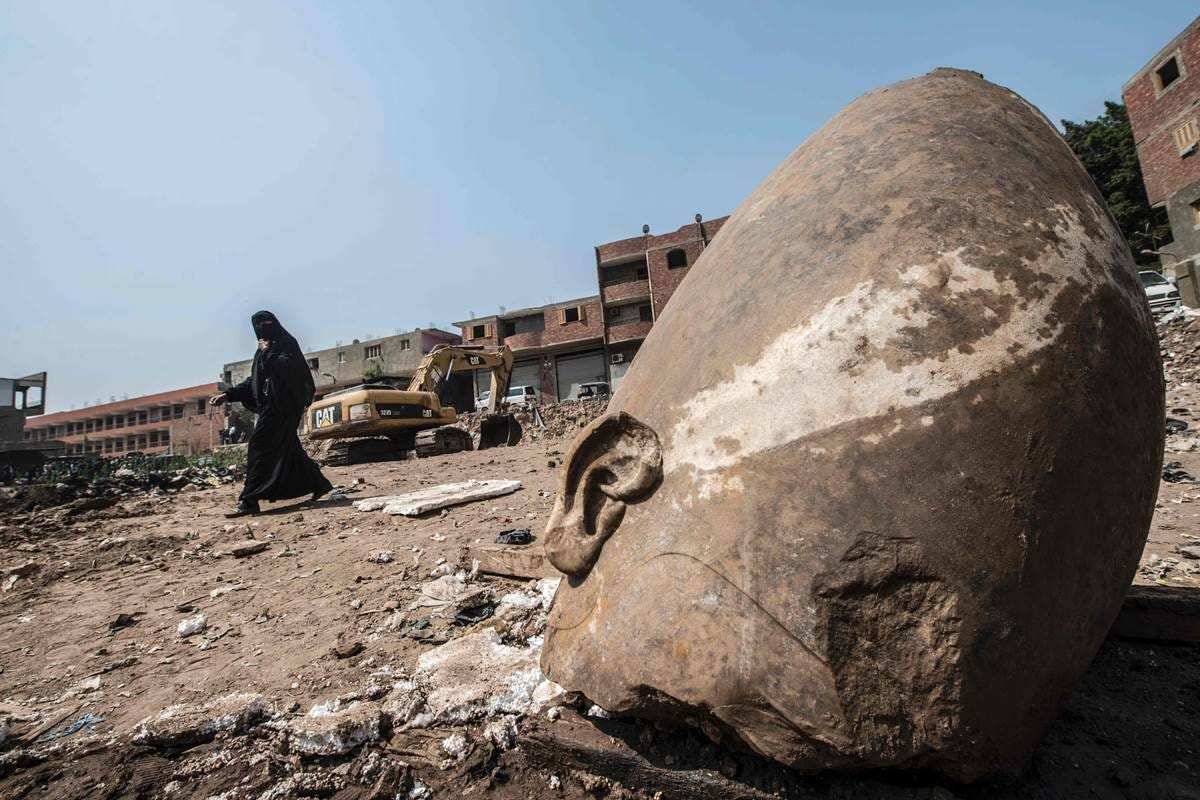My name is Ozymandias, King of Kings
Look on my Works, ye Mighty, and despair!
ακολουθεί κείμενο στα ελληνικά
I met a traveller from an antique land, Who said—“Two vast and trunkless legs of stone Stand in the desert. . . . Near them, on the sand, Half sunk a shattered visage lies, whose frown, And wrinkled lip, and sneer of cold command, Tell that its sculptor well those passions read Which yet survive, stamped on these lifeless things, The hand that mocked them, and the heart that fed; And on the pedestal, these words appear: My name is Ozymandias, King of Kings; Look on my Works, ye Mighty, and despair! Nothing beside remains. Round the decay Of that colossal Wreck, boundless and bare The lone and level sands stretch far away.
Percy Bysshe Shelley, The Examiner, issue of January 11, 1818.
In September 2013, the best episode in the history of television aired. It is the only episode that has held a 10/10 rating on IMDb for such a long period and has also topped other lists, such as the one by Rolling Stone magazine.
It is an episode of the series Breaking Bad, titled "Ozymandias."
The word is known from the eponymous poem by Percy Shelley, published in 1818, which uses the image of a statue of Ozymandias to describe the inevitable decline of all leaders and empires, no matter how powerful they were in their time.
In the episode, we see the protagonist Walter White collapsing in the sand, as it is said to have happened with the famous statue. In 2013, Breaking Bad released a promotional video in which Bryan Cranston read the entire poem. You can watch below a 2013 animation by Stephen Hamacek that I enjoy visit quite often:
At Christmas of 1817, Percy Bysshe Shelley and Horace Smith decided to engage in an artistic competition, each writing and publishing a poem titled "Ozymandias" in the same newspaper.
Their subject was based on the mention by the ancient Greek historian Diodorus Siculus (1st century BCE) of a colossal statue of an Egyptian king with the enigmatic name 'Ozymandias,' who stood arrogantly and confidently by the Nile. The name was historically unknown as nobody had yet deciphered the Egyptian hieroglyphs, so it remained a mystery what the common Pharaoh was called.
Shelley and Smith wrote two masterpieces of European literature, painting with verse the power of fate. It was the era of relentless Romanticism, which saw in the ruins of antiquity the violence of destiny and, in the future, the futility of those who believe in certainties. Of the two, Shelley's sonnet was to endure longer through time.
It is worth noting that in the last years of his life, Shelley lived in Switzerland and Italy, where among others, he developed a friendship with Lord Byron, another prominent representative of 19th-century Romanticism, who died in revolutionary Greece shortly after and Alexandros Mavrokordatos, a Greek scholar who played an important role later in the Greek Revolution. In fact, Shelley dedicated to the latter his theatrical drama Hellas, in which he celebrates the Greek Revolution of 1821 against the Turkish yoke, inspired by the ancient greek tragedy Persae (Persians), by Aeschylus.
In 2017, two hundred years after the peculiar poets' contest, the "Ozymandias of Matariya" came to light, a colossal statue of Ramses II in a neighborhood of Cairo with muddy streets, poor inhabitants, hardworking laborers, smiling grandfathers, and countless happy children—those very ones who need no poetic education to know innately that every giant eventually turns to dust.
Until next time, ἐρρῶσθε καὶ εὐδαιμονεῖτε.
Whether it's just the price of a coffee or a book, every contribution matters. Donations help cover research, writing, and the resources needed to keep sharing my passion for uncovering the past and bringing history, archaeology, and culture to life. If you enjoy my work and would like to support it in continuing to create and share this content, consider making a donation or becoming a paid subscriber.
ακολουθεί κείμενο στα ελληνικά
I met a traveller from an antique land, Who said—“Two vast and trunkless legs of stone Stand in the desert. . . . Near them, on the sand, Half sunk a shattered visage lies, whose frown, And wrinkled lip, and sneer of cold command, Tell that its sculptor well those passions read Which yet survive, stamped on these lifeless things, The hand that mocked them, and the heart that fed; And on the pedestal, these words appear: My name is Ozymandias, King of Kings; Look on my Works, ye Mighty, and despair! Nothing beside remains. Round the decay Of that colossal Wreck, boundless and bare The lone and level sands stretch far away.
Percy Bysshe Shelley, The Examiner, τεύχος της 11ης Ιανουαρίου, 1818.
Τέτοιες μέρες τον Σεπτέμβριο του 2013, βγήκε στον αέρα το καλύτερο επεισόδιο στην ιστορία της τηλεόρασης. Είναι το μοναδικό επεισόδιο που έχει βαθμολογία 10/10 στο IMDB για τόσο μεγάλο χρονικό διάστημα και έχει αναδειχθεί πρώτο και σε άλλες λίστες όπως αυτή του περιοδικού Rolling Stone. Είναι το επεισόδιο της σειράς Breaking Bad, με τίτλο "Ozymandias".
Η λέξη είναι γνωστή από το ομώνυμο ποίημα του Percy Shelley, που δημοσιεύτηκε το 1818, το οποίο χρησιμοποιεί την εικόνα ενός αγάλματος του Οζυμανδία για να περιγράψει την αναπόφευκτη παρακμή όλων των ηγετών και αυτοκρατοριών, ανεξάρτητα από το πόσο ισχυροί ήταν στην εποχή τους.
Στο επεισόδιο βλέπουμε τον πρωταγωνιστή Walter White να καταρρέει στην άμμο, όπως λέγεται ότι συνέβη με το διάσημο άγαλμα. Το 2013, το Breaking Bad κυκλοφόρησε ένα προωθητικό βίντεο στο οποίο ο Bryan Cranston διάβασε ολόκληρο το ποίημα. Εδώ σε ένα αγαπημένο μου animation του Stephen Hamacek:
Τα Χριστούγεννα του 1817, ο Percy Bysshe Shelley και ο Horace Smith, αποφάσισαν να αναμετρηθούν καλλιτεχνικά, γράφοντας και δημοσιεύοντας στην ίδια εφημερίδα από ένα ποίημα με τίτλο "Ozymandias".
Θέμα τους ήταν η αναφορά του αρχαίου Έλληνα συγγραφέα Διόδωρου Σικελιώτη (1ος αι. π.Χ.) σε ένα κολοσσιαίων διαστάσεων άγαλμα Αιγύπτιου βασιλιά με το αινιγματικό όνομα 'Οζυμανδίας', που στεκόταν αλαζονικό και βέβαιο για τη δύναμή του, πλάι στο Νείλο. Το όνομα ήταν ιστορικώς ανύπαρκτο, αφού κανείς δεν είχε ως τότε αποκρυπτογραφήσει τα αιγυπτιακά ιερογλυφικά κι έτσι παρέμενε άγνωστο πώς έλεγαν τον μέσο Φαραώ.
Οι Shelley και Smith έγραψαν τότε δύο αριστουργήματα της ευρωπαϊκής λογοτεχνίας, ζωγραφίζοντας με στίχους τη δύναμη του πεπρωμένου. Ήταν η εποχή του ανελέητου ρομαντισμού, που έβλεπε στα ερείπια της αρχαιότητας τη βία της μοίρας και στο μέλλον, τη ματαιότητα όσων πιστεύουν σε βεβαιότητες. Από τα δύο, έμελλε να αντέξει περισσότερο στο χρόνο το σονέτο του Shelley.
Αξίζει να σημειωθεί ότι τα τελευταία χρόνια της ζωής του ο Shelley τα έζησε στην Ελβετία και την Ιταλία, όπου μεταξύ άλλων ανέπτυξε φιλία με τον Λόρδο Βύρωνα, άλλον σημαντικό εκπρόσωπο του ρομαντισμού του 19ου αιώνα και τον Αλέξανδρο Μαυροκορδάτο, Έλληνα λόγιο που έπαιξε σημαντικό ρόλο λίγα χρόνια αργότερα στην ελληνική επανάσταση. Μάλιστα, αφιέρωσε στον τελευταίο το θεατρικό του δράμα Ελλάς, στο οποίο υμνεί την Ελληνική Επανάσταση του 1821 ενάντια στον τουρκικό ζυγό και το οποίο είναι εμπνευσμένο από την τραγωδία του Αισχύλου Πέρσαι.
Το 2017, διακόσια χρόνια μετά τον ιδιότυπο διαγωνισμό των ποιητών, ήλθε στο φως ο "Ozymandias της Matariya", ένα κολοσσιαίο άγαλμα του Ραμσή Β΄ σε μια γειτονιά του Καΐρου με λασπωμένους δρόμους, φτωχούς κατοίκους, εργάτες του μόχθου, ευτυχισμένους παππούδες και άπειρα πιτσιρίκια, δηλαδή εκείνους ακριβώς, που δεν χρειάζονται καμιά ποιητική παιδεία για να γνωρίζουν εκ γενετής πως κάθε γίγαντας, στο τέλος, γίνεται σκόνη.
Whether it's just the price of a coffee or a book, every contribution matters. Donations help cover research, writing, and the resources needed to keep sharing my passion for uncovering the past and bringing history, archaeology, and culture to life. If you enjoy my work and would like to support it in continuing to create and share this content, consider making a donation or becoming a paid subscriber.








I encountered Shelley's Ozymandias when I was a freshman in high school, the year when I first read great literature. The power of these words astonished me, and the memory has stayed with me. Thank you for adding to my appreciation of this great poem.
Wonderful stack. All indeed turns to dust.